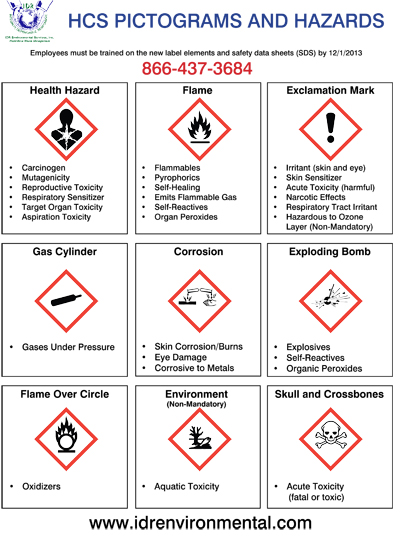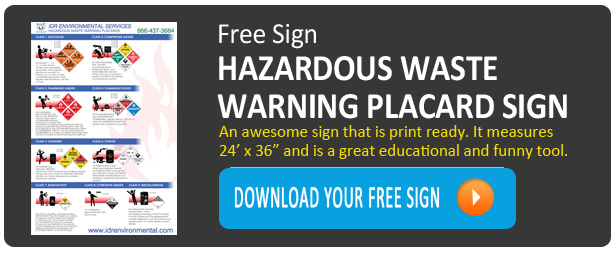OSHA's Hazard Communication Standard (HCS)

Major changes to the Hazard Communication Standard
The following information has been taken from the United State Department of Labor – OSHA website regarding the new Globally Harmonized System of Classification and Labeling of Chemicals (GHS) and Hazard Communication Standard (HCS)
The new hazard communication standard, also known as OSHA's hazard commincation standard and hazard communication standard pictograms, still requires chemical manufacturers and importers to evaluate the chemicals they produce or import and provide hazard information to employers and workers by putting labels on containers and preparing safety data sheets. However, the old standard allowed chemical manufacturers and importers to convey hazard information on labels and material safety data sheets in whatever format they chose. The modified standard provides a single set of harmonized criteria for classifying chemicals according to their health and physical hazards and specifies hazard communication elements for labeling and safety data sheets.
Major changes to the Hazard Communication Standard
- Hazard classification: Provides specific criteria for classification of health and physical hazards, as well as classification of mixtures.
- Labels: Chemical manufacturers and importers will be required to provide a label that includes a harmonized signal word, pictogram, and hazard statement for each hazard class and category. Precautionary statements must also be provided.
- Safety Data Sheets: Will now have a specified 16-section format.
Information and training: Employers are required to train workers by December 1, 2013 on the new labels elements and safety data sheets format to facilitate recognition and understanding.
Reference Material on the New Hazard Communication Standards
For a quick reference guide to the Hazard Communications Standards we have collected OSHA’s Quick Card Sheets for you to use. Click on the link for the Quick Card Sheet of your choice:
- Safety Data Sheet – English Spanish
- Labeling - English & Spanish
- Pictograms - English & Spanish
- Training Requirements for the Revised Hazard Communication Standard - English
Downloadable Sign of the Hazard Communication Standards Pictograms & Hazards
We have developed a sign to help train your employees based on the HCS standards. Download it for free here:


Changes from the Proposed to the Final Rule: OSHA reviewed the record and revised the Final Rule in response to the comments submitted. Major changes include:
- Maintaining the disclosure of exposure limits (Threshold Limit Values [TLVs]) established by the American Conference of Governmental Industrial Hygienists (ACGIH) and carcinogen status from nationally and internationally recognized lists of carcinogens on the safety data sheets;
- Clarification that the borders of pictograms must be red on the label;
- Flexibility regarding the required precautionary and hazard statements to allow label preparers to consolidate and/or eliminate inappropriate or redundant statements; and
- Longer deadlines for full implementation of the standard (see the chart below).
What you need to do and when:
- Chemical users: Continue to update safety data sheets when new ones become available, provide training on the new label elements and update hazard communication programs if new hazards are identified.
- Chemical Producers: Review hazard information for all chemicals produced or imported, classify chemicals according to the new classification criteria, and update labels and safety data sheets
Effective Dates
The table below summarizes the phase-in dates required under the revised Hazard Communication Standard (HCS)
|
Effective Completion Date |
Requirement(s) |
Who |
|
12/1/2013 |
Train employees on the new label elements and safety data sheet (SDS) format. |
Employers |
|
6/1/2015 |
Compliance with all modified provisions of this final rule, except: |
Chemical manufacturers, importers, distributors and employers
|
|
12/1/2015 |
The Distributor shall not ship containers labeled by the chemical manufacturer or importer unless it is a GHS label |
|
|
6/1/2016 |
Update alternative workplace labeling and hazard communication program as necessary, and provide additional employee training for newly identified physical or health hazards. |
Employers |
|
Transition Period to the effective completion dates noted above |
May comply with either 29 CFR 1910.1200 (the final standard), or the current standard, or both |
Chemical manufacturers, importers, distributors, and employers |
The GHS does not include harmonized training provisions, but recognizes that training is essential to an effective hazard communication approach. The revised Hazard Communication Standard (HCS) requires that workers be re- trained within two years of the publication of the final rule to facilitate recognition and understanding of the new labels and safety data sheets.
For a side-by-side comparison of the current HCS and the final revised HCS please see OSHA's hazard communication safety and health topics webpage at: https://www.osha.gov/dsg/hazcom/side-by-side.html
How will labels change under the revised Hazard Communication Standard?
Under the current Hazard Communication Standard (HCS), the label preparer must provide the identity of the chemical, and the appropriate hazard warnings. This may be done in a variety of ways, and the method to convey the information is left to the preparer. Under the revised HCS, once the hazard classification is completed, the standard specifies what information is to be provided for each hazard class and category. Labels will require the following elements:
- Pictogram: a symbol plus other graphic elements, such as a border, background pattern, or color that is intended to convey specific information about the hazards of a chemical. Each pictogram consists of a different symbol on a white background within a red square frame set on a point (i.e. a red diamond). There are nine pictograms under the GHS. However, only eight pictograms are required under the HCS.
- Signal words: a single word used to indicate the relative level of severity of hazard and alert the reader to a potential hazard on the label. The signal words used are "danger" and "warning." "Danger" is used for the more severe hazards, while "warning" is used for less severe hazards.
- Hazard Statement: a statement assigned to a hazard class and category that describes the nature of the hazard(s) of a chemical, including, where appropriate, the degree of hazard.
- Precautionary Statement: a phrase that describes recommended measures to be taken to minimize or prevent adverse effects resulting from exposure to a hazardous chemical, or improper storage or handling of a hazardous chemical.
For a detailed Hazard Communication Standard Pictogram sign you can use in your place of business, just click the link below to download a FREE version. The sign is print ready and is 8.5” x 11” in size.


Comment